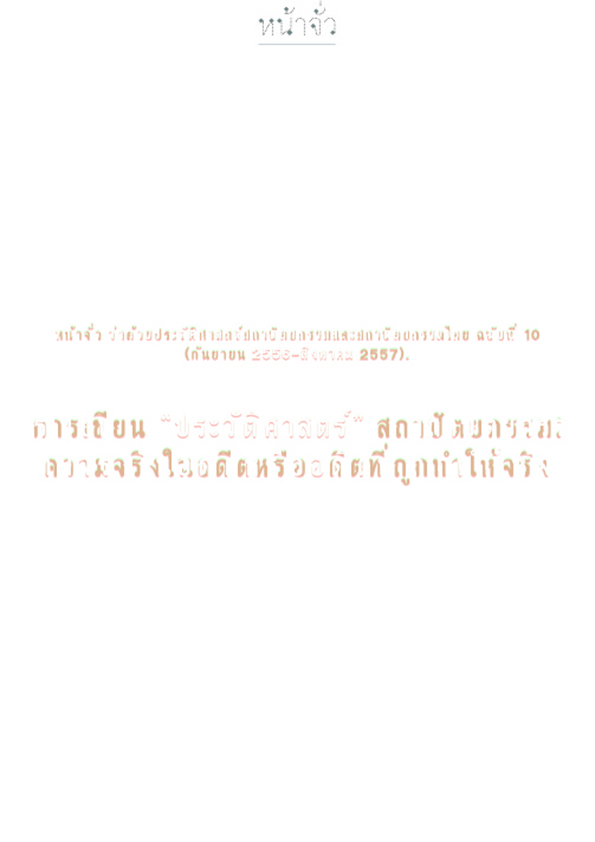คุ้มหลวงและเวียงแก้วของเจ้าเชียงใหม่ในสมัยรัชกาลที่ 5 : เรื่องราวที่ไม่ถูกเล่าถึงในพงศาวดารสยาม และร่องรอยที่พบในหลักฐานอื่น King of Chiang Mai’s “Khum Luang”/“Wiang Khaew” in the era of King Chulalongkorn
Main Article Content
Abstract
บทคัดย่อ
บทความเรื่องนี้ศึกษาเรื่องราวของคุ้มหลวงและเวียงแก้วซึ่งเป็นที่ประทับของกษัตริย์ล้านนาจากพงศาวดารของสยามที่เขียนขึ้นเมื่อรัฐบาลกรุงเทพฯสามารถผนวกรวมล้านนาเข้าเป็นส่วนหนึ่งของสยามได้สำเร็จในสมัยรัชกาลที่ 5 ประกอบกับหลักฐานประเภทจดหมายเหตุ บันทึกชาวต่างชาติ และประวัติศาสตร์บอกเล่า โดยอาศัยวิธีการทางประวัติศาสตร์และแนวคิดเรื่องอาณานิคมภายใน (Internal Colonialism) ที่เสนอว่ารัฐบาลสยามจัดการดินแดนล้านนาในรูปแบบเดียวกับที่มหาอำนาจตะวันตกใช้กับประเทศ อาณานิคมของตน
จากการศึกษาพงศาวดารของสยามเล่มสำคัญที่เขียนเกี่ยวกับประวัติศาสตร์ของล้านนา คือ พงศาวดารโยนกของพระยาประชากิจกรจักร (แช่ม บุนนาค) พบว่า พงศาวดารฉบับนี้ถูกเขียนขึ้นเพื่อเล่าเรื่องของการสร้างรัฐไทยที่มีกรุงเทพฯ เป็นศูนย์กลาง โดยกล่าวถึงเรื่องการฟื้นเมืองเชียงใหม่ ซึ่งถูกทิ้งร้างหลังพม่าเข้ายึดครองเพียงสั้น ๆ ระบุเพียงว่า พระเจ้ากาวิละให้กวาดต้อนคนเข้าเมืองและตั้งหลักเมือง ไม่ได้กล่าวถึงการตั้งคุ้มหลวงและเวียงแก้ว ซึ่งเป็นที่ประทับของกษัตริย์เชียงใหม่และเป็นศูนย์กลางการปกครองล้านนา ในขณะที่บันทึกชาวต่างชาติและประวัติศาสตร์บอกเล่าของคนในท้องถิ่นแสดงให้เห็นว่าคุ้มหลวงและเวียงแก้วมีความสำคัญอย่างมาก และกษัตริย์เชียงใหม่ในยุคที่จักรวรรดินิยมตะวันตกแผ่อำนาจเข้ามาได้ตกแต่งคุ้มหลวงให้มีความทันสมัยแบบตะวันตก ยิ่งไปกว่านั้นจากจดหมายเหตุของสยามแสดงให้เห็นว่า หลังจากที่รัฐบาลกรุงเทพฯ ในสมัยรัชกาลที่ 5 เข้าไปปกครองล้านนาอย่าง เต็มตัว ได้มีการเปลี่ยนแปลงคุ้มหลวงและเวียงแก้วให้เป็นสถานที่ราชการ ทั้งที่มีนัยเชิงบวก เช่น ศาลาราชการ โรงเรียน และสถานที่ที่มีนัยเชิงลบได้แก่ เรือนจำ ซึ่งการกระทำเช่นนี้มีลักษณะของการจัดการอาณานิคมภายในที่รัฐบาลกลางเข้าไปจัดการท้องถิ่นที่เป็นอาณานิคมตามความต้องการของรัฐบาล โดยลบความสำคัญของสถานที่สำคัญหรือสถานที่ศักดิ์สิทธิ์ตามความเชื่อหรือจารีตของคนท้องถิ่น และให้เหตุผลของการเปลี่ยนแปลงพื้นที่ว่าเป็นเรื่องที่รัฐบาลเห็นว่ามีความเหมาะสม
Abstract
The aim of this article is to study the story of Khum Luang/ Wieng Khaew, the palace of King of Chiang Mai, from Siam chronicles, which were written after the annexation of Chaing Mai by Siam in the era of King Chulalongkorn. Besides the chronicles, other sources like archival documents, memoirs and oral history should also be studied alongside with the concept of internal colonialism.
The main thai-chronicle of lanna-history, the Yonok Historical Annual, written by Phraya Prachakitkorrajak (Cham- Bunnag), aimed to tell the story of building the Siam-state with Bangkok as a center. As one stage of establishing the Thai-state, the Yonok Historical Annual talks about the renovation of Chiang Mai, the center of Lanna, that took place after the short occupation of the Burmeses. The chronicle states that, King Kawila drove back the people to the city and ordered the establishing of the city pillar. In telling these, the chronicle doesn’t mention Khum Luang/Wiang Khaew, which refer to a palace of the King of Chiang Mai and thus the government-center of Lanna. Controversially, both royal houses were mentioned in several memoirs of foreigners in Lanna and in oral history as a place as big importance, which decorated in western styles in the time of colonialism.
Moreover, the Siam archival documents show that, after the annexation of Lanna, Khum Luang and Wiang Khaew were rebuilt into places with positive meaning-such as, town hall and school and negative meaning-such as, a prison. Rebuilding the palace into a prison means a degradation of a palace. Furthermore, it also shows the influence of Siamese government in Bangkok over the colonized Lanna, since the Siamese government could do what it saw fit.


